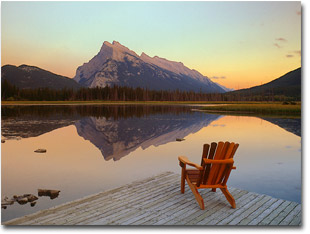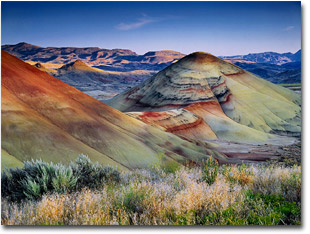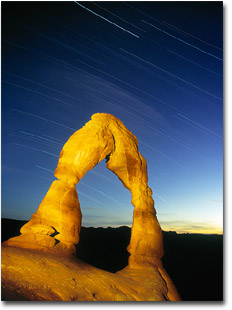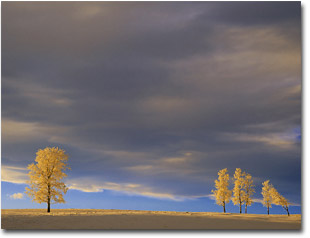|
|

My Nature Photography Pet Peeves
Text and photography Copyright Darwin Wiggett Imagine arriving at a beautiful mountain lake before dawn. You stroll around looking for that perfect foreground to compliment the stunning mountain backdrop. You find a group of partially submerged boulders that form a triangular shape that leads the eye into the frame and out towards the mountain backdrop. Perfect! You set up your tripod, finesse the composition, and you wait for the sun to kiss the peaks. Then, just as you start to shoot your first frame, another photographer elbows in beside you, sets up his tripod and chatters away like a squirrel on speed. “What aperture are you using? What kind of filter is that? Do you have any spare batteries?” On and on he goes peppering the silence with his endless monologue. Meanwhile, the mist rises off the lake in serpentine coils, the peaks are lit fiery orange by the rising sun, and a few scattered clouds repeat the triangular shape of your selected foreground. This is the photographic opportunity of dreams but your new ‘friend’ chooses this moment to show you his spiffy new 14 – 800mm f1.8 Ultra-Spunky zoom lens. You want to capture the glory nature reveals; he wants to reveal the entire content of his camera bag. What should you do? Lemmings Nearly every time I shoot in a location that is popular with tourists and photographers, I run into the same problem. It seems that many shooters think that the exact spot where I am set up is the ‘right’ or the ‘only’ spot for shooting, no matter how spacious the surroundings. Other photographers I have spoken with have similar experiences. Set up a tripod anywhere, and if another photographer is within 50 miles, within seconds that photographer will magically appear by your side.
Once, when a photographer overlapped his legs with my tripod, I asked, “How come you have to shoot right beside me?” His answer, “Well you got the best spot in the whole place!” I told him that he was free to have my spot, I would move elsewhere. I wandered about 500 metres away and found a spot I liked even better. Within 15 minutes the other photographer had moved three times, successively closing the distance between us until on his fourth move his tripod legs were once again interlocked with mine. When I shoot around other photographers my first priority is to find a spot far away from everyone else. Maybe I am just anti-social, but I assume the last thing a nature photographer would want is someone crowding them. I give all photographers a wide berth so not to disturb them, but also so I do not end up in their compositions by accident. I can not count the number of times that I have set up a really nice composition only to have another photographer wander directly in front of my camera to set up his shot. To my way of thinking, if someone is already set up and shooting, it is rude to muscle your way in beside them without first asking permission especially where shooting space is abundant and varied. Often there are many ‘right spots’ and it is just a matter of searching for a spot to call your own. Don’t get so hung up with what the other person is shooting, concentrate on your own vision of the scene. Grizzly Bears I realize some locations truly have ‘marquee’ shooting spaces with little elbowroom. Here I expect crowds, and generally, folks are courteous and make room for everyone. However, I have seen bizarre behavior at these locations as well. Sometimes a photographer (often a pro) will arrive early and stake his territory. Like a grizzly on a fresh kill, the photographer will snarl and charge anyone who gets to close. “Stay away, I got here first! Find your own spot!” I’ve seen grown photographers resort to pushing and name-calling in childish squirmishes over six inches of territory. Sometimes even if you are innocent of being ‘territorial’, you will be perceived as rude by your photographic behavior. Once, I had brought my own deck chair as a prop for shooting in Banff National Park. I set up the chair, composed my shot and took a variety of images as the sun arched lower in the sky (Photo 1). A lady showed up and stood behind me, arms crossed and looking very stern. I thought she was just interested in watching what I was doing. Finally, she told me that my time with the chair was up and it was her turn to use it! Apparently she assumed that Parks Canada strategically scattered deck chairs around the park for the enjoyment of the visitors and that I was hogging the chair. I tried to explain that I owned the chair but if she wanted the spot to herself I would gladly move. “Are you going to leave the chair?” she asked. “No”, I said, "it’s my chair, I’ll be taking it with me.” She stomped off muttering something about reporting me to the park wardens. Peacocks Even when everyone is getting along in a shooting space, there are those shooters that feel it is their birthright to give everyone in earshot ‘good advice’. On and on… and on… they go about how everyone is doing everything wrong. “He is using the wrong lens, she’s set the wrong shutter speed, that guy is using wrong camera brand”. They yap about all the ways THEY would shoot the scene, yet ignore their cameras the whole time they lecture! When asked why they are not shooting, the canned response is “well, the light isn’t really right”.
Then there is the ‘format snobbery’. If you are shooting with 35mm, the guy with medium format automatically assumes you have no talent and he thumbs his nose at you. The guy with 4x5 thinks the medium format dude is essentially just a ‘point-n-shoot’ idiot. If you shoot digital you’re a ‘cheater’, if you shoot with film, you’re a ‘Luddite’. None of these guys (yes it is always GUYS) are really shooting… most are just posturing like peacocks in the spring. These guys spend more time looking over their shoulders to make sure everyone is watching them than they do taking photos. The Peacock scenario rises exponentially as the number of photographers increase at a site (the more photographers, the bigger the Peacock displays). Peacocks love an audience and they are thrilled when someone engages them by seeking advice. Wouldn’t it be nice if people kept their advice to themselves and concentrated on their own photography? For those folks seeking advice and hoping to learn by watching others work in the field, simply ask for information once there is an obvious lull in the shooting. Soliciting advice from someone who is madly tripping the shutter may not generate the result you had hoped for. Vultures As more and more landscape imagery is published, the places where these images were taken are being visited more and more frequently. You can’t blame folks, the first time I saw a photo of the Painted Hills in Oregon, I decided I had to go there (Photo 2). It was simply too amazing to pass up! Destinations like Delicate Arch in Utah have become a Mecca for nature shooters. When I visited Delicate Arch one evening at sunset, there were already 76 other photographers there waiting to capture the sunset light! Anyone that has been there knows just how little space there is to accommodate such a crowd.
Everyone politely jockeyed around for a good tripod position and all was hushed as the shooters waited for the sun to get lower in the sky. Casually a family with three kids in tow wandered down under the arch for a close up view of the fantastic rock formation. Almost immediately the group of photographers started booing and yelling at the family to get out of the way. This frenzied harassment of curious tourists by the photographers became more intense as the sun arched lower in the sky. Soon, no one dare approach the arch for fear of being butchered by the aggressively vocal photographers. What right did the photographers have to monopolize a natural wonder just because they were photographers? How could they deny little Joey the opportunity to go down and place his hand on a remarkable geographical feature? At that point I was truly ashamed to be a nature photographer. When the sun was within 15 minutes of setting someone tripped his shutter, setting off an avalanche of shutter clicks. The sound of shutters and motor drives reached a crescendo as the sun sat on the horizon painting warm light across Delicate Arch. Once the sun dipped below the hills, the deafening roar of winding cameras was replaced a thunderous applause from the photographers. Within 10 minutes everyone had packed up and gone rushing down the trail before darkness fell. My shooting companion and I were left alone with the desert mice, the little animals frantically competing for the left over granola and gorp dropped by the waiting photographers. We had a pleasant two-hour shoot of Delicate Arch under the sky doing star trails and light-painting the arch with a flashlight (Photo 3) but the obnoxious group behavior we had witnessed earlier had really soured our tastes for visiting the other “iconic” spots in the Moab area. We moved on to BLM lands and avoided the National Parks for the rest of our trip. No wonder many park managers want to restrict photographers and require permits for photography. Park wardens I have talked with often have serious issues with nature photographers. Some of our photographic peers believe the rules of the park don’t apply to them. These photographers stray off marked trails, they remove, rearrange and trample vegetation, they crowd and harass wildlife, hog scenic overlooks, block highway traffic, and are generally annoying to other visitors. If we, as a group, allow this poor behavior to continue we may find our rights as photographers further eroded on public lands. Lone Wolf The glory spots of nature photography will continue to be visited and photographed in creative new ways by plenty of shooters. And many will enjoy the camaraderie and friendships that develop as a result of shooting with others. Many shooters enjoy being approached by fellow shooters, chatting up gear, exchanging techniques, and sharing great locations. Others just want to be left alone as much as possible. What is one person’s ‘pet peeve,’ is another’s blessing. To each his own, but maybe we need to develop general rules of etiquette that will apply to everyone so we are less likely to ruffle the feathers of fellow photographers and tourists as popular locations get more crowded.
The General Discussion Forum on this site is the perfect platform for discourse on how and if we should develop rules of etiquette for nature photographers (I am sure wildlife shooters have even more concerns than I have expressed here). This article is merely a starting point for discussion. I am afraid that my experiences in the past have colored my shooting behavior at present. I photograph nature for the emotional and spiritual connection I get from the activity. I find that connection harder to achieve in the socially competitive atmosphere of the photographic ‘hotspots’. I have voluntarily backed off from the ‘glory spots’ mostly because I want to experience nature without the crowds. I now spend more and more time shooting little known spots, and ‘ordinary’ locations close to home. I find great enjoyment in discovering ‘fresh’ views and I especially enjoy being able to make ‘something from nothing’, shooting in spots that others wouldn’t give a second look (like in Photo 4 of hoar frosted trees at sunset in a local rancher’s field). I like what I find away from the crowds. I love the solitude, the time for reflection; the joy of receiving what nature gives. I guess I have solved the etiquette problem by backing away from encountering it. It will be interesting to hear what the rest of you have done. Darwin Wiggett - NPN 343 Editor's Note - Natural Moments Photography is comprised of the husband and wife shooting team of Anita Dammer and Darwin Wiggett. Anita has 17 years experience as staff photographer for the Glenbow Museum in Calgary and is currently doing freelance stock photography. Darwin has been shooting stock since 1990, is a contibuting editor to Canada's "Photo Life" magazine and has two books published by Whitecap in Vancouver ("Darwin Wiggett Photographs Canada" and "Seasons in the Rockies"). Together they specialize in landscape, nature, animal, humor and kid photography. Comments on NPN nature photography articles? Send them to the editor. |
|
|



